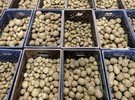Potatoes are a widely-loved vegetable. Baked, mashed, fried or chipped, they are a tasty treat. But they aren’t perfect. Potatoes present a big challenge for the plant breeders who work on the crop, trying to develop new varieties that are more savory, sustainable, storable or growable.
“Potato is the world’s leading vegetable crop, but it hasn’t realized the genetic gains needed to keep pace with industry and consumer demands,” says Jeff Endelman, UW–Madison associate professor in the horticulture department, who heads the university’s potato breeding program.
 One of the main hurdles when breeding potatoes is its tetraploid genome. Tetraploids inherit two sets of chromosomes from each parent instead of just one set, like humans and most animals. “Tetraploidy is common enough among flowering plants that scientists believe it has advantages on evolutionary time scales,” says Endelman. “But for plant breeders, it makes it difficult to understand the genetics of traits and get rid of unfavorable genes through selection.”
One of the main hurdles when breeding potatoes is its tetraploid genome. Tetraploids inherit two sets of chromosomes from each parent instead of just one set, like humans and most animals. “Tetraploidy is common enough among flowering plants that scientists believe it has advantages on evolutionary time scales,” says Endelman. “But for plant breeders, it makes it difficult to understand the genetics of traits and get rid of unfavorable genes through selection.”
To circumvent the challenges of tetraploidy, potato breeders around the world are working to reinvent cultivated potato as a diploid crop—an effort informally known as Potato 2.0. UW–Madison is playing an important role in this effort as the lead institution for a national project titled “Developing a new paradigm for potato breeding based on true seed.” The project was made possible through a $3 million award from the USDA Specialty Crop Research Initiative (SCRI) and $3 million in matching funds from PepsiCo and the eight universities and research institutions involved.
The first step of the project is to produce diploid potatoes that still have the optimal genetics of their tetraploid relatives. This is done by pollinating tetraploid potato with special diploids (that already exist) that can act as “haploid inducers.” Haploid induction is a technique used in many crop species to reduce chromosome numbers and results in an embryo without the chromosomes of the pollen donor.
“Our goal is to create and sequence the genomes of 100 diploid potatoes, representing the russet, chip, and red market types that comprise most of US potato production,” explains Endelman.
The next step is to create lines that can be maintained as “true seed,” which is potato jargon for what everyone else simply calls seed. The “seeds” currently used in potato production are pieces of tuber with at least one “eye,” from which sprouts develop to generate the next crop. Seed tubers are bulky, expensive to transport, and potential carriers of disease.
“It takes about 2000 pounds of seed tubers to plant one acre, but the amount of true seed needed would fit in the palm of your hand,” says Endelman.
Another major focus of the project is to produce inbred, or self-pollinated, lines. Although it may sound trivial, this is actually a big challenge in diploid potatoes, as is selecting for traits that potato growers want in those inbred lines. That process took decades in the early 20th century for corn breeders, but Endelman hopes to do it more quickly in potatoes now that researchers have the genomic tools needed.
Endelman is excited to see the future impacts of the overall project across the potato industry, in Wisconsin and beyond. “This project marks a turning point for ‘Potato 2.0’ in the US, and everyone is enthusiastic about the potential to more efficiently deliver genetic improvements for disease resistance, climate resilience, nutritional value and more.”
Source: College of Agricultural & Life Sciences
"potato" - Google News
October 16, 2020 at 06:17PM
https://ift.tt/2T11vju
Project to develop new potato varieties will benefit breeders, growers and consumers - FreshPlaza.com
"potato" - Google News
https://ift.tt/2rh4zOj
Shoes Man Tutorial
Pos News Update
Meme Update
Korean Entertainment News
Japan News Update
Bagikan Berita Ini















0 Response to "Project to develop new potato varieties will benefit breeders, growers and consumers - FreshPlaza.com"
Posting Komentar